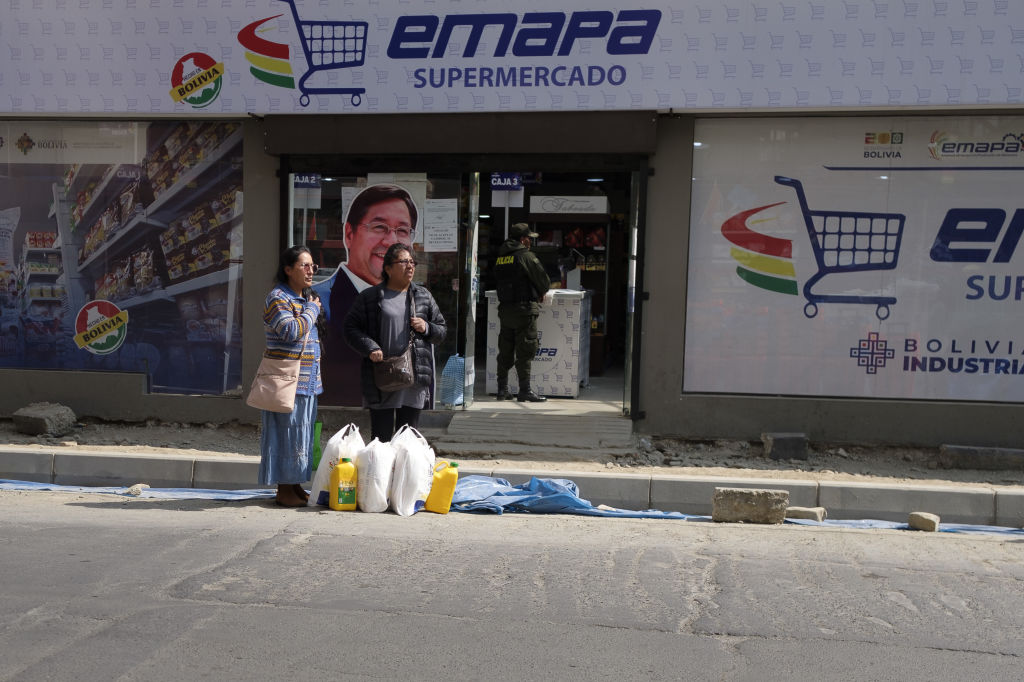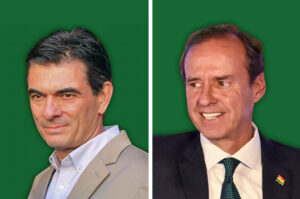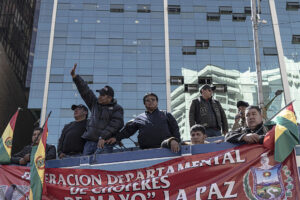LA PAZ—Bolivia is heading into uncharted territory as the August 17 elections near. For the first time in two decades, former President Evo Morales, the leader of the once-dominant Movimiento al Socialismo (MAS) will not appear anywhere on the ballot. Meanwhile, the public is preparing to vote with inflation at 24%, its highest level in over three decades, making the presidential race an unpredictable test for the political system and its institutions.
For Bolivians, it is a wholly new experience to see polls indicating that two right-wing opposition leaders, most likely Samuel Doria Medina and Jorge Quiroga, could advance to a runoff on October 19. The reason, polling suggests, is that economic concerns now outweigh political ones for most Bolivians amid a crisis marked by a shortage of U.S. dollars, scarce fuel, and rising inflation. In the country’s highly polarized environment, protests occur almost daily, and highway blockades in the countryside are exacerbating the shortages.
No matter who wins, the next president will have to implement painful reforms. These include reducing a fiscal deficit that has hovered around 10% for years, possibly tripling domestic fuel prices, and negotiating with international lenders, such as the International Monetary Fund, to secure the dollars needed to stabilize the economy and the nation’s foreign trade.
In a report on May 30, the IMF recommended that Bolivia adopt “a credible and sustained fiscal consolidation” to rationalize the nation’s wages, phase out fuel subsidies, enhance public investment and spending efficiency, and boost tax revenue. “Eliminating monetary financing of fiscal deficits is also important,” the multilateral lender stated, noting that the country’s central bank has financed the deficit despite tight external conditions and the fact that public debt has increased to 95% of GDP.
President Luis Arce, who has opted not to seek reelection due to his low approval ratings, continues to defend his administration. Earlier this week, he blamed national lawmakers for failing to pass key bills that would authorize external funding. “When there are economic problems, they point to the government as if we were the culprits,” Arce said Arce said at a public event in La Paz. “The culprits are sitting in the Legislative Assembly, because they don’t approve loans, because they want to make us look bad in front of the people by saying we don’t know how to do anything.” According to Arce’s Planning Ministry, the legislative branch has 17 bills under review that are expected to trigger $1.7 billion in investments.
A cascading dollar crisis
At the turn of the century and during its first decade, high commodity prices lifted many economies in Latin America, and Bolivia became the second-largest beneficiary of the boom, behind only Venezuela. By 2014, Bolivia had accumulated nearly $14 billion in foreign reserves, largely thanks to gas exports. However, the country failed to encourage enough exploration, and government gas revenue plummeted from $5.5 billion a decade ago to under $1.6 billion last year.
The government, nevertheless, has maintained expensive subsidies and propped up a fixed exchange rate, and the country now likely has well under $2 billion in reserves. Most of that is gold, and the central bank may hold less than $50 million in hard foreign currency reserves, Fitch Ratings said when it downgraded the nation’s credit rating to CCC- in January.
Fuel subsidies have been a major source of spending, amounting to nearly $3 billion annually. Now, due to the fiscal crunch, the government imports less, resulting in common shortages. Long lines have formed at gas stations across the country, where truck and car drivers sometimes wait days to fill their tanks.
All major presidential hopefuls, even the leading MAS-aligned candidate, Andrónico Rodríguez, agree that fuel subsidies will need to be cut—the only questions are how much, how fast, and how intensely the public will protest. Fuel prices could triple without subsidies. When the agribusiness group Anapo announced a month ago that it had begun importing fuel from Brazil, it said it was paying more than three times the domestic selling price.
Meanwhile, the process of attracting new investment in the gas sector could take years. It would likely require broad political consensus on the need for significant reform to cut taxes on the gas industry and otherwise incentivize private sector participation. Even then, the government would also need to work to convince investors that Bolivia is overall a credible investment destination.
Addressing the shortage
The shortage of U.S. dollars has hit imports across the board, worsening inflation for basic goods, including medicines. The fixed exchange rate maintained by the Arce administration has become untenable. For the first time in 40 years, a black-market dollar rate has emerged. For now, the dollar gets around 14 bolivianos on the black market compared to just 6.96 bolivianos through official channels.
Dollar shortages have become so severe that a banking “corralito” has taken hold: Depositors are unable to withdraw dollars from their accounts and are instead given bolivianos at the official rate. Devaluation is already a reality on the street, and a painful official devaluation seems all but inevitable.
Arce has been unable to attract dollars to right the ship. His efforts to approve lithium contracts that promise $1.4 billion in investment from a Chinese and a Russian company, for example, have stalled in the Legislative Assembly, due largely to the ruling party’s internal divisions. The situation is no better in the broader mining sector; gold exports generate minimal revenue for the state, and the Mutún iron plant has only just begun operations.
The major candidates all agree that to bolster the supply of dollars the country will need to secure major loans. Opposition candidates are focused on the IMF and similar multilateral lenders, while Andrónico Rodríguez, the leading MAS-affiliated leftist candidate, leans instead toward options like BRICS.
Any deal will require tradeoffs. Traditional multilateral loans will demand significant spending cuts as well as measures to improve transparency in public finances. It may also be necessary to shut down loss-making state-owned enterprises and lay off a number of public employees, for example.
These challenges await whoever becomes the next president. If an opposition candidate wins and the right returns to power after two decades in the wilderness, painful rationalization measures will threaten the administration’s stability. If the leftist Rodríguez prevails, he may well also face a hostile majority in the new legislature. The road out of Bolivia’s economic crisis will be a hard one for whatever government takes shape.








